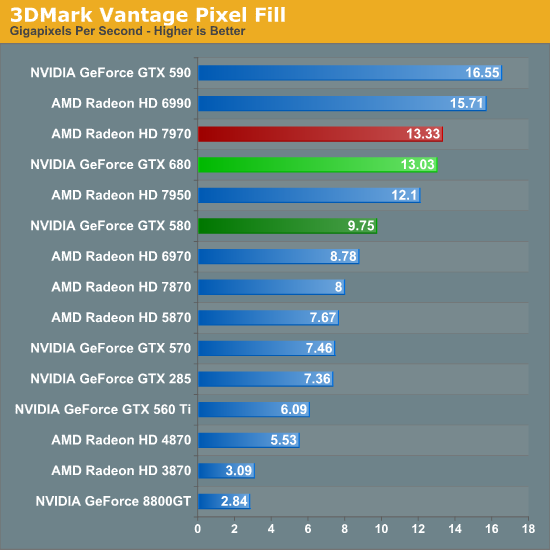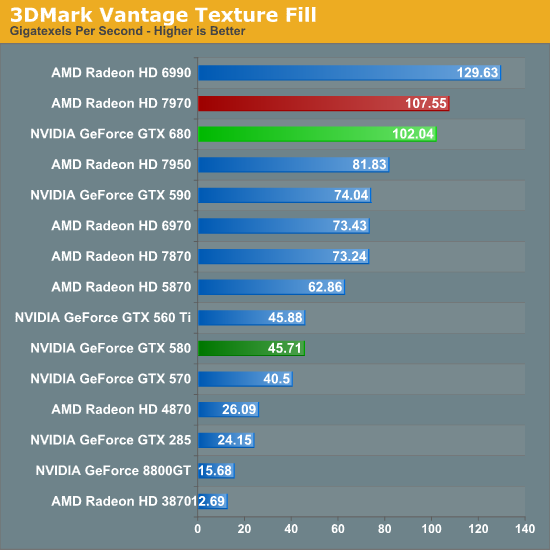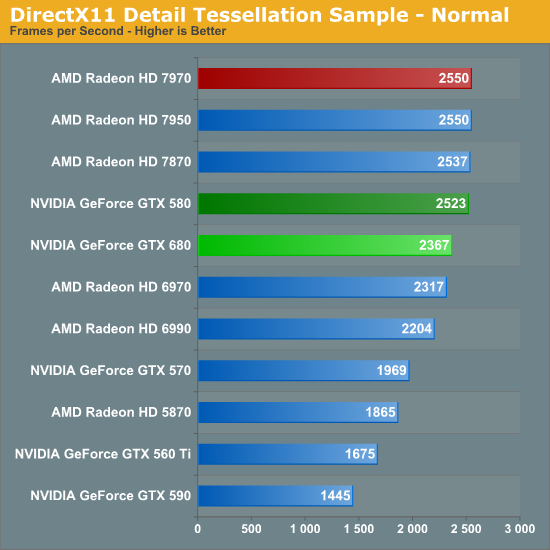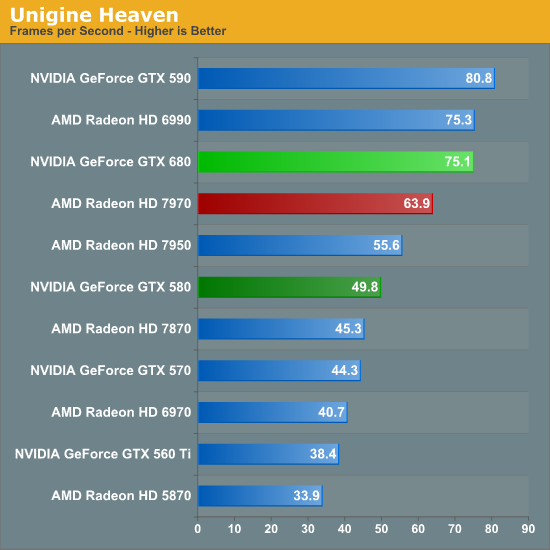NVIDIA GeForce GTX 680 Review: Retaking The Performance Crown
by Ryan Smith on March 22, 2012 9:00 AM ESTTheoreticals
As with any new architecture, we want to take a few moments to look at theoretical performance. These numbers shouldn’t be taken too seriously for cross-vendor comparison, but these numbers often tell us more about interesting architectural improvements that occur from one generation to the next.

Our first theoretical test is perhaps the most perplexing: 3DMark Vantage’s pixel fill test. Typically this test is memory bandwidth bound as the nature of the test has the ROPs pushing as many pixels as possible with as little overhead as possible, which in turn shifts the bottleneck to a mix of ROP performance and the memory bandwidth needed to feed those ROPs.
Compared to the GTX 580, the GTX 680 has almost exactly the same amount of memory bandwidth (192GB/sec) and only 86% of the theoretical ROP performance (37Gpix vs. 32Gpix). In short, it shouldn’t outperform the GTX 580 here, and yet it outperforms the 580 by 33%.
Why does it do this? That’s the hard thing to answer. As we mentioned in our look at GK104’s architecture, NVIDIA did make some minor incremental improvements to their ROPs coming from GF114, such as slightly improved compression and improved polygon merging. One of those may very well be the contributing factor, particularly the compression improvements since this is a typically memory bandwidth bottlenecked test. Alternatively, it’s interesting to note that the difference between the two video cards is almost identical to the difference in the core clock. GTX 560 Ti’s results tend to blow a hole in this theory, but it bears consideration.
In any case, it’s an interesting turn of events and hopefully one that isn’t simply an edge case. As we’ve seen in our benchmarks GTX 680 has strong performance – even if its lead compared to the 7970 diminishes with resolution – but compared to the GTX 580 in particular it needs strong ROP performance across all games in order to deliver good performance at high resolutions and anti-aliasing.

Our second theoretical test is 3DMark Vantage’s texture fill test, which to no surprise has the GTX 680 handily clobbering all prior NVIDIA cards. NVIDIA’s inclusion of 128 texture units on GK104 versus 64 on their previous generation GPUs gives the GTX 680 far better texturing performance. The 30%+ core clock difference only serves to further widen the gap.


Our third theoretical test is the set of settings we use with Microsoft’s Detail Tessellation sample program out of the DX11 SDK. Overall while NVIDIA didn’t make any significant changes to their tessellation hardware (peak triangle rate is still 4/cycle), they have been working on further improving performance at absurdly high tessellation factors. You can see some of this in action at the max factor setting, but even then we’re running into a general performance wall since the Detail Tessellation program can’t go to the absolute highest tessellation factors NVIDIA’s hardware supports.

Our final theoretical test is Unigine Heaven 2.5, a benchmark that straddles the line between a synthetic benchmark and a real-world benchmark as the engine is licensed but no notable DX11 games have been produced using it yet. In any case the Heaven benchmark is notable for its heavy use of tessellation, which means it’s largely a proxy test for tessellation performance. Here we can see the GTX 680 shoot well ahead of the GTX 580 – by more than we saw in the DX11 Detail Tessellation sample – but at the same time there’s a lot more going on in Heaven than just tessellation.
Honestly at this point in time I’m not sure just how much more tessellation performance is going to matter. Until DX11 is the baseline API for games, tessellation is still an add-on feature, which means it’s being used to add fine detail to specific models rather than being used on everything in a game world. This demands good tessellation at high factors but at the same time it’s subject to diminishing returns on the improvement to image quality as triangles reach single pixel sizes and smaller. To that end I’m still waiting to see the day where we see tessellation scale similarly to textures – that is by using full MIP chaining of displacement maps – at which point we can evaluate tessellation performance similar to texture performance when it comes to both measuring the performance hit and evaluating the difference in image quality.










404 Comments
View All Comments
Wreckage - Thursday, March 22, 2012 - link
Impressive. This cards beats AMD on EVERY level! Price, performance, features, power..... every level. AMD paid the price for gouging it's customers, they are going to lose a ton of marketshare. I doubt they have anything to match this for at least a year.Creig - Thursday, March 22, 2012 - link
The review has been up for less than a minute so you couldn't possibly have read it already. How pathetic is it that you were sitting there hitting F5 repeatedly just so you could get in another "First post! Nvidia is uber!" comment.Get a life.
Grooveriding - Thursday, March 22, 2012 - link
Haha Creig,Good observation, he must of been sitting there spamming to get in that first comment, before he read a word of the review.
Sour grapes at being banned much, Wreckage ?
nathanddrews - Thursday, March 22, 2012 - link
... but he's correct. The 680 does dominate in nearly every situation and category."the GTX 680 is faster, cooler, and quieter than the Radeon HD 7970. NVIDIA has landed the technical trifecta, and to top it off they’ve priced it comfortably below the competition."
Obvioulsy Wreckage's analysis of AMD's "price gouging" and prophesies of doom are farfetched...
N4g4rok - Thursday, March 22, 2012 - link
Well, yeah, the card does well in most of those tests, but i think it might be a little too far to say that it dominates the 7970 on every level.cactusdog - Thursday, March 22, 2012 - link
Just finsished looking around various sites and the 680 isnt as good as was suggested.Dont forget, you're basically comparing an overclocked Nvidia card to a stock AMD card, and even the base clock is much higher on the nvidia card.
At the same clocks the results will look much better for AMD. Also, 3 monitor gaming could favour AMD with 3GB of vram.
Seems like Nvidia really wanted to target the 7970 and the price/performance tag this time, by building a souped up, overclocked Gk104 but its not a 7970 killer. AMD will just need to sell them for $449.
AMD can stay with the 7970 as planned until Q4 and the 8 series.
gamerk2 - Thursday, March 22, 2012 - link
You know clocks aren't the only thing that determines speed? Couldn't one just as easily argue that AMD cards were better because they basically clocked their RAM so high?Fact is, at stock, the card beats the 7970 at a lower price. Period.
Meaker10 - Thursday, March 22, 2012 - link
You're ignoring the host of factory overclocked models out there that will be quieter than the 680M and perform on a similar level, the price just needs to be dropped.Kakkoii - Thursday, March 22, 2012 - link
Herp derp, the same can be said about Nvidia cards as well. The 680 has tonnes of OC'ing headroom. The GPU boost it has is a messily overclock.CeriseCogburn - Thursday, March 22, 2012 - link
I guess the lower clocked cores of 470, 480, 570, 580 , and many other Nvidia cards were greatly cheated in all benchmarks because the amd cores were often well over 100mhz higher at stock....So we have had at least 3 years of lying benchmarks in amd's favor.
I'd like to personally thank gamerk2 for this very astute observation that sheds the light of Nvidia asbolutely winning in all the above mentioned nvidia cars for the past couple of years.
Thank you... (sarc/reality check is free)